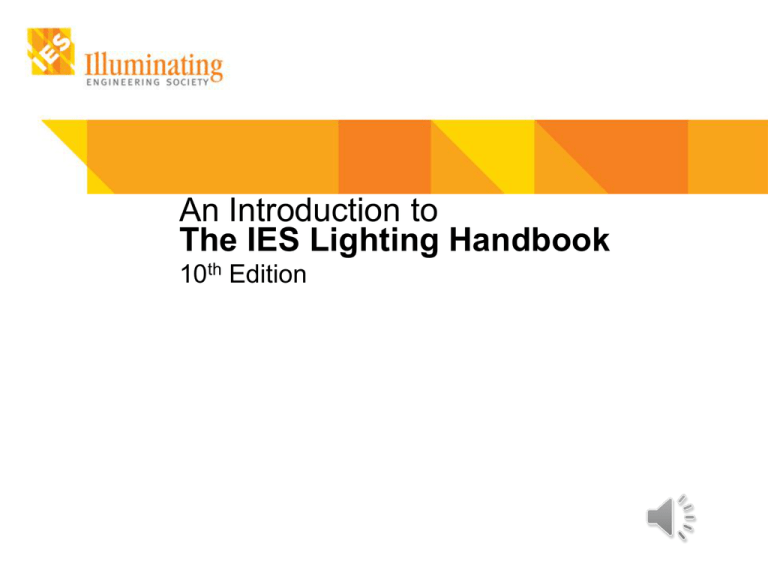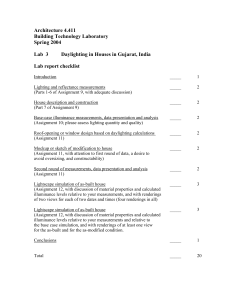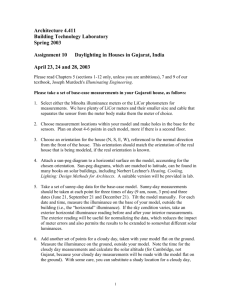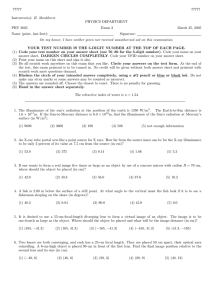An Introduction to The IES Lighting Handbook
advertisement

An Introduction to The IES Lighting Handbook 10th Edition An Introduction to the New IES Lighting Handbook by David L. DiLaura Lighting Handbook Editors David L. DiLaura Principal Illuminating Engineer Acuity Brands Lighting Gary R. Steffy Principal Gary Steffy Lighting Design (c) Kevin Beswick Richard G. Mistrick Associate Professor of Architectural Engineering Pennsylvania State University Kevin W. Houser Associate Professor of Architectural Engineering Pennsylvania State University Brief History of IES Handbooks Why a New Book? Initial Development; Setting, Scope, and Content Characteristics and Format of the New Handbook Highlights of Significant Changes A bit of Lighting Handbook History The 1st Handbook • Developed during 1942-1947 The 1st Handbook • Handbook Committee as overseer • Individual contributors • Produced by IES editorial staff Beginning with the 8th Handbook • Independent contractor and editor • Committee authorship of chapters Changes in the Lighting Industry • Rapid advance of solid-state lighting • Rise of environmental influences • Ever-diminishing power allotments for lighting Changes affecting the IES • Increased competition for influence and authority • New generation of members from different backgrounds A New Lighting Handbook: Setting the Stage Handbook Task Force • Members: –Maninder Dhaliwal –Kevin Flynn (chair) –Stefan Graf –Rita Harrold –Matt Latchford –Alan L. Lewis –Paul Torcellini Handbook Task Force • Recommendations regarding content • Recommendations regarding format • Marketing • Editor/Publisher • Contractor –David L. DiLaura, LC, FIES, AAAS, DSc(Hon) • Subcontractors –Gary R. Steffy, LC, FIALD, AIAMI(Hon) –Richard G. Mistrick, PhD, FIES, PE –Kevin W. Houser, PhD, PE, LC, LEED Defining the New Lighting Handbook Goals • Direct IES knowledge outward • Influence architectural lighting as it is practiced • Make specific recommendations Audience • IES members • Broad range of lighting practitioners • Architects, Planners, Designers, Engineers, Distributors, Contractors Technology Content Update • Solid-State lighting • Visual performance and mesopic adaptation • Lighting Controls Form and Format • Sustainable and revisable • References and active interlinks • Deliverable in several different media Learning from the Past, Adjusting to the Present, and Predicting the Future: the Form and Content of the New Lighting Handbook Fundamentals Section with a Tight Focus Lighting Design Issues Gathered into a Single Section Highlighted Presence of Daylighting and Sustainability New Illuminance Recommendations Redefined Purpose and Intent of Application Chapters Content of the New Lighting Handbook Three Sections: Framework • Background to lighting • Supporting information Design • Principles of Lighting Design • Components of Lighting Design • An Approach to Lighting Design Applications Framework • Physics and Optics of Radiant Power • Vision: Eye and Brain • Photobiology and Nonvisual Effects of Optical Radiation • Perceptions and Performance P • Concepts and Language of Lighting • Color P P • Light Source: Technical Characteristics • Luminaires: Forms and Optics • Measure of Light: Photometry • Calculation of Light and its Effect P Design • Lighting Design in the Building Design Process • Components of Lighting Design P • Light Sources: Application Considerations • Designing Daylighting P • Designing Electric Lighting • Lighting Controls P • Energy Management • Economics • Sustainability P • Contract Documents P P P P Applications P • Lighting for Art • Lighting for Common Applications • Lighting for Courts and Correctional Facilities • Lighting for Education • Lighting for Emergency, Safety, and Security • Lighting for Exteriors • Lighting for Health Care • Lighting for Hospitality and Entertainment • Lighting for Libraries • Lighting for Manufacturing Applications P • Lighting for Miscellaneous Applications • Lighting for Offices • Lighting for Residences • Lighting for Retail • Lighting for Sports and Recreation • Lighting for Transport • Lighting for Worship Generating the Content Editors Were Responsible for all Text Topic and Sentence Outlines • Four editors generated topic outlines for all chapters Topic Outline Approval • 30 External experts • Revision and rewriting outlines • Handbook Task Force review • Board of Directors and TRC reviewed and approved Chapter Production • One of 4 editors assigned as lead author • Full access to all comments and record of changes Writing the Chapters • Text drafting by lead author • 4 Editors’ internal review, and subsequent rewriting • External experts’ review, and subsequent rewriting • Final review and rewrite by lead author • IES Board of Directors and TRC review and approval Development of Graphics Formatting Changes and New Features Formatting • Printed Version –Full color throughout –1270 pages • PDF Version –Fully searchable –12,000+ hyperlinks –96 Mbytes Local Table of Contents Section Numbering Definitions, Details Quick Locator Tabs Resource Pointers Help Custom Graphics to Clarify and Abbreviate the Text Help Custom Graphics to Clarify and Abbreviate the Text Custom Graphics to Clarify and Abbreviate the Text Custom Graphics to Clarify and Abbreviate the Text Framework Design Principles and Examples of Design Well Illustrated with Tables and Photographs Hundreds of Color Photographs Demonstrate Design Principles and Show Examples of Lighting Applications. All Linked to Explanatory Text and Tables. Applications Significant Changes in the Content of the New Lighting Handbook Light Source Information: Data and Application Daylighting Tightly-Focused Application Chapters New Illuminance Determination Procedure Significant Changes in the Content of the New Lighting Handbook Light Source Information: Data and Application Daylighting Tightly-Focused Application Chapters New Illuminance Determination Procedure Two Chapters Devoted to Sources • Light Sources: Technical Characteristics • Electric Light Sources: Application Considerations Revision of Light Sources Technical Information • Characteristics of –Sunlight and Skylight –Filament lamps –Fluorescent lamps –HID –Sold-State Sources Revision of Light Sources Technical Information • In each case: –Principles of operation –Construction –Spectrum –Operating characteristics –Nomenclature Source Application Considerations and Guidance • Efficacy, Life, and Lumen Maintenance • Auxiliary Equipment • Starting, Restriking, and Dimming • Color • Geometry, Distribution • Sustainability, Legislation, Standards, Cost of Light Significant Changes in the Content of the New Lighting Handbook Light Source Information, Data, and Application Daylighting Tightly-Focused Application Chapters New Illuminance Determination Procedure Extensive Material on Daylighting • Daylighting design process • Programming • Daylighting design parameters and tools –Building orientation –Glazing materials –Daylight delivery systems –Shading devices • Daylight assessments Principles and Methods Show with Detailed Examples Significant Changes in the Content of the New Lighting Handbook Light Source Information, Data, and Application Daylighting Tightly-Focused Application Chapters New Illuminance Determination Procedure Separated from Committee Recommended Practice (RPs) • Limited Scope • Reference to applicable general principles in design chapters • Analytic Recommendations –Illuminances –Luminances –Ratios and Uniformities –Maxima and Minima –Veiling Reflections –Daylighting Opportunities Every Application Chapter Has a Table of Contents, An Introduction to put the Application in Context, and References to Material Common to all Applications. Every Application Chapter Begins with a Checklist of Design Issues, Keyed to Relevant Sections of the Handbook Significant Changes in the Content of the New Lighting Handbook Light Source Information, Data, and Application Daylighting Tightly-Focused Application Chapters New Illuminance Determination Procedure New Illuminance Determination Procedure • Need –Properly manage ever diminishing power allotments –Augment existing recommendations with more modes • Uniformities • Ratios • Maxima and Minima –Assert and maintain authority over recommendations New Illuminance Determination Procedure • Required Characteristics –Fine granularity of ranges or steps –Account for • Task difficulty and importance • Age of observer • Environment • Mesopic Adaptation New Illuminance Determination Procedure: Ranges New Illuminance Determination Procedure: Ranges New Illuminance Determination Procedure: Ranges New Illuminance Determination Procedure: Age Retina Pupil Lens New Illuminance Determination Procedure: Age 2.35 Decrease in Pupil Area New Illuminance Determination Procedure: Age 2.15 Loss in Light New Illuminance Determination Procedure: Age 2.35 Decrease in Pupil Area 2.15 Loss in 5 times Less Light x Light = On the Retina Transmittance New Illuminance Determination Procedure: Age Conventional or legacy recommendations are for middle-age observers. Old observers require twice the illuminance Young observers require one-half the illuminance New Illuminance Determination Procedure: Environment New Illuminance Determination Procedure: Environment New Illuminance Determination Procedure: Environment New Illuminance Determination Procedure: Environment New Illuminance Determination Procedure: Environment New Illuminance Determination Procedure: Development Legacy Recommendations • Old tasks, previous two handbooks, existing RPs New Recommendations • New tasks • New environmental constraints –Light trespass –Dark sky –Lighting Zones –Activity levels Final Application Committee Approval New Illuminance Determination Procedure: Specification Specific Recommendations • Horizontal illuminance • Vertical illuminance • Illuminance location • Uniformity ratios • Maxima and Minima • Recommendations as to “Gauge” (Max, Min, Ave) • Flags for daylighting opportunities • Flags to indicate where the designer should establish coverage • Cautions for veiling reflections New Illuminance Determination Procedure: Specification New Illuminance Determination Procedure: Specification New Illuminance Determination Procedure: Adaptation • Research in Visual Performance at Mesopic Adaptation under illuminances of different spectra –Realistic and simulated tasks –Reaction time measurements –Mesopic adaptation states –Various spectra • Photometry Based on Intermediate (mesopic) v( ) Functions Predicts Reaction Times New Illuminance Determination Procedure: Adaptation Scotopic Adaptation Luminance < 0.001 cd/m2 Mesopic Adaptations 0.001 cd/m2 < Luminance < 10 cd/m2 Photopic Adaptation Luminance > 10 cd/m2 New Illuminance Determination Procedure: Adaptation • Adaptation State –Expressed as a Photopic Luminance • Spectrum –Expressed as a Ratio of Scotopic to Photopic Lumens New Illuminance Determination Procedure: Adaptation • The New Handbook recommends the Average Photopic Luminance in the Field of View be used to Determine the State of Adaptation New Illuminance Determination Procedure: Adaptation • The New Handbook recommends that the Spectrum be specified by its S/P • S/P: Ratio of Scotopic to Photopic Lumens –A single number that indicates the relative amount of short wavelength optical radiation in a spectrum S( ) Scotopic Lumens –S/P = = Photopic Lumens 1700 S( ) v’()d 683 S( ) v()d New Illuminance Determination Procedure: Adaptation • The New Handbook recommends the use of Mesopic Multipliers to Scale Photopic Recommended Illuminances –Multipliers depend on adaptation state –Multipliers depend on spectrum, as expressed by S/P –Multipliers provide the transformation (scaling) from mesopic to photopic photometry –All analyses uses only photopic photometry New Illuminance Determination Procedure: Adaptation Luminance (0.03) Source S/P (1.81) Recommendation multiplier (0.70) New Illuminance Determination Procedure: Adaptation • Mesopic Multipliers can be used to: –Determine how the State of Adaptation and –The Spectrum of the Proposed Lighting System –Modify a Photopic Recommended Illuminance • Mesopic Multipliers should NOT be used to modify Photopic Recommended Illuminances in Applications where Vehicular Traffic Moves at Speeds > 40 kph (25 mph) New Illuminance Determination Procedure: Adaptation Determining a Mesopic Multiplier Requires Estimating the Adaptation Luminance The Average Luminance in the Field of View can be Used as the Adaptation Luminance. New Illuminance Determination Procedure: Adaptation Recall that if a surface is diffusely reflective with a reflectance of ρ and enjoys an average illuminance of E, then its average luminance L is: LE If the illuminance is in lux, the luminance will be candela/m2 New Illuminance Determination Procedure: Adaptation If Other Information is not Available, it is Reasonable to Assume that: –The photopic illuminance recommendation, Erec, will be produced by a proposed lighting system –Thus, the average surface illuminance will be the recommended photopic illuminance, Erec –The average surface luminance will be L Erec New Illuminance Determination Procedure: Adaptation •The Adaptation Luminance Depends on How Much of the Field of View the Surface Fills –A parking garage floor that fills ½ the field of view –The other ½ of the field is assumed to be the dark sky with a luminance of essentially zero –This would produce an adaptation luminance, La, of 1 1 La L Erec 2 2 New Illuminance Determination Procedure: Adaptation •For Multiple Surfaces, the Average Luminance Depends on the Luminance and Apparent Size of Each –The full field of view is 5 steradians in solid angle –If, for example, there are 3 surfaces with luminances L1, L2, and L3, and – 1 , 2 , 3 are the solid angles subtended to the observer by the surfaces, –then the adaptation luminance, La, is L1 1 L2 2 L3 3 La 5 New Illuminance Determination Procedure: Adaptation •Most of us will probably let Lighting Calculation Software make these calculations for us Summary New, 10th Edition of the IES Lighting Handbook –Designed and Produced for the Widest Possible Audience –Printed and PDF Formats –New, Focused Application Chapters –Flexible, Sustainable, Illuminance Recommendations –Extensive Daylighting, Sustainability, and Lighting Control Information –Updated Electric Light Source Information –The Most Useful and Authoritative Lighting Reference Editors: Technical Direction: Special Publisher: Thanks To: David Lof DiLaura Rita Harrold IESWilliam Board Hanley Directors Kevin W Houser Technical Review Council Richard Committees G Mistrick Application IES Lighting Handbook Gary R Steffy 10th Edition http://www.ies.org/handbook http://www.ies.org/handbook



